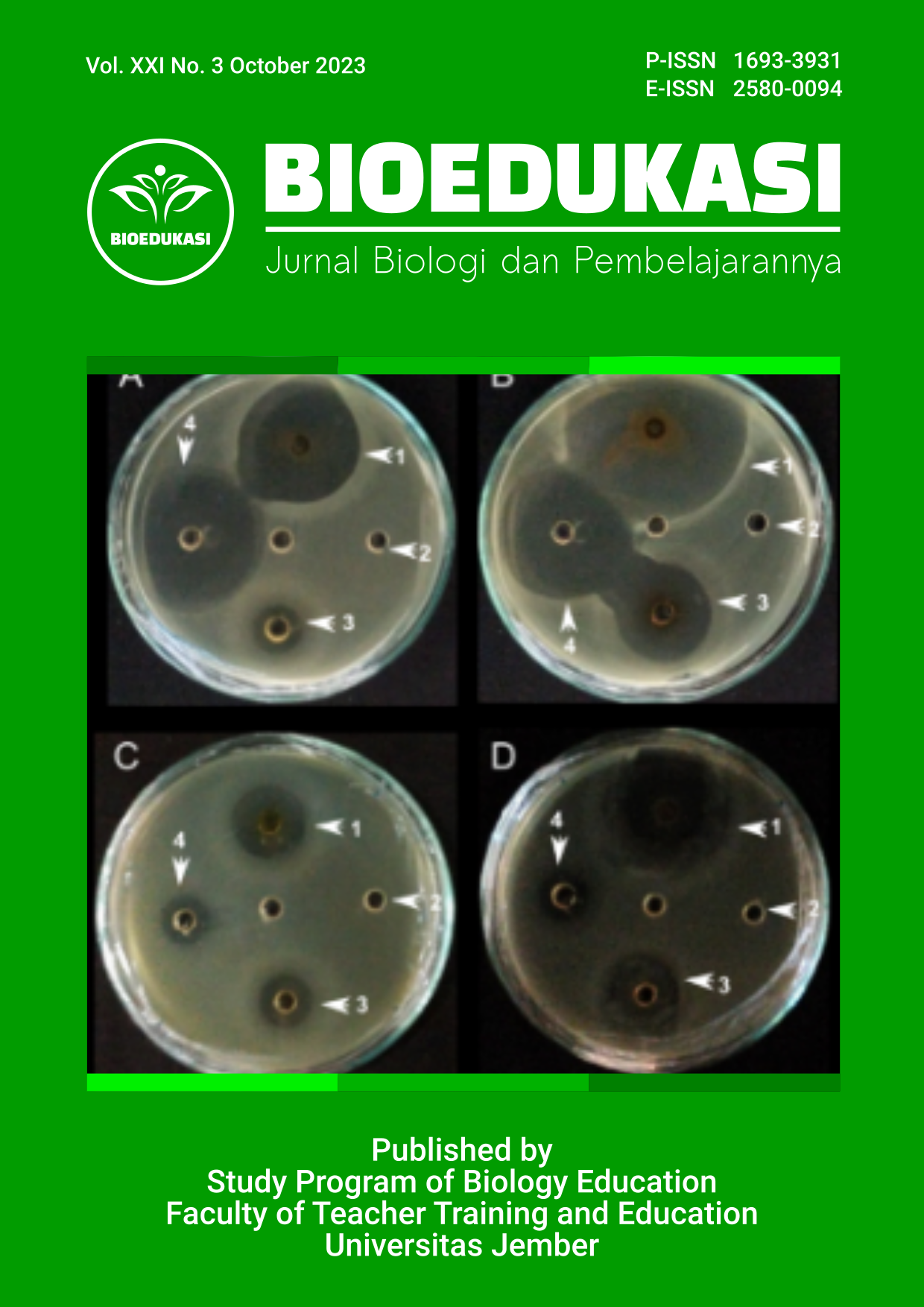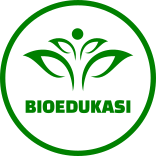Relationship Between Technology Literacy and Communication Skills with Environmental Literacy of Class X Students of SMAN 2 Malang
DOI:
https://doi.org/10.19184/bioedu.v21i3.40186Keywords:
Communication Skills, Environmental Literacy, Technology LiteracyAbstract
The aim of this study is to determine the relationship between technology literacy and communication skills in environmental literacy of class X SMAN 2 Malang. The methods using survey research with a correlational design to determine the relationship. Research subjects selected using simple random sampling. The subjects are 34 class X students of SMAN 2 Malang in social sciences and language majors. The research instruments are questionnaires on technology literacy and communication skills, and environmental literacy questionnaires and tests. Data analysis includes prerequisite, correlation and regression tests. The results showed that the values of technology literacy, communication skills, and environmental literacy are classified in the high category. The correlation between technology literacy and environmental literacy is -0.007 classified as very low category, the correlation between communication skills and environmental literacy is -0.207 classified as very low category, the correlation between technology literacy and communication skills is -0.903 classified as very strong category, and the correlation between technology literacy and communication skills together with environmental literacy is 0.048 classified as very low category.
Downloads
References
Donnelly-Hermosillo, D. F., Gerard, L. F., & Linn, M. C. (2020). Impact of graph technologies in K-12 science and mathematics education. Computers and Education, 146. https://doi.org/10.1016/j.compedu.2019.103748
Greenstein, L. (2012). Assesing 21st ceentury Skills: A Guide to Evaluating Mastery and Authentic Learning.
Hamia, H., Muhidin, P., & Arsal, A. F. (2021). Keterampilan Komunikasi Peserta Didik: Studi Kasus pada Pembelajaran Biologi Di SMA negeri 1 Sidrap.
Haske, A. S., & Wulan, A. R. (2015). Pengembangan E-learning Berbasis Moodle Untuk Meningkatkan Literasi Lingkungan Siswa Pengembangan E-learning berbasis MOODLE dalam Pembelajaran Ekosistem untuk Meningkatkan Literasi Lingkungan Siswa pada Program Pengayaan. Seminar Nasional XII Pendidikan Biologi FKIP UNS, 402–409.
Helaluddin. (2019). Peningkatan Kemampuan Literasi Teknologi dalam Upaya Mengembangkan Inovasi Pendidikan di Perguruan Tinggi. PENDAIS, 1(1), 44–55.
Huda, N. F. D., Assjari, M., & Tjasmini, M. (2019). Penggunaan Sistem Komunikasi Alternatif I-Talk Untuk Meningkatkan Keterampilan Komunikasi Siswa Cerebral Palsy. JASSI_anakku, 20(2), 31–43.
Huggins, A. C., Ritzhaupt, A. D., & Dawson, K. (2014). Measuring Information and Communication Technology Literacy using a performance assessment: Validation of the Student Tool for Technology Literacy (ST2L). Computers and Education, 77, 1–12. https://doi.org/10.1016/j.compedu.2014.04.005
Indraswari, R. R., & Yuhap, R. J. (2017). Faktor-Faktor Yang Memengaruhi Penundaan Kelahiran Anak Pertama Di Wilayah Perdesaan Indonesia: Analisis Data SDKI 2012. Jurnal Kependudukan Indonesia , 12(1), 1–12.
Kusumaningrum, D. (2018). Literasi Lingkungan Dalam Kurikulum 2013 dan Pembelajaran IPA di SD. Indonesian Journal of Natural Science Education (IJNSE), 1(2), 57–64.
Lagur, D. S., Makur, A. P., & Ramda, A. H. (2018). Pengaruh Model Pembelajaran Kooperatif Tipe Numbered Head Together Terhadap Kemampuan Komunikasi Matematis. Mosharafa: Jurnal Pendidikan Matematika, 7(3), 357–368. http://journal.institutpendidikan.ac.id/index.php/mosharafa
Latip, A. (2020). Peran Literasi teknologi Informasi dan Komunikasi Pada Pembelajaran Jarak Jauh Di MAsa pandemi Covid-19. EduTeach: Jurnal Edukasi Dan Teknologi Pembelajaran , 1(2), 107–115.
Makiyah, Y. S., Mahmudah, I. R., Sulistyaningsih, D., & Susanti, E. (2021). Hubungan Keterampilan Komunikasi Abad 21 Dan Keterampilan Pemecahan Masalah Mahasiswa Pendidikan Fisika. Journal of Teaching and Learning Physics, 6(1), 1–10. https://doi.org/10.15575/jotalp.v6i1.9412
Malini, G. A. dan F. I. G. A. (2017). Perbedaan motivasi belajar siswa ditinjau dari jenis kelamin dan urutan kelahiran di SMAN 1 Tabanan dengan sistem full day school. Jurnal Psikologi Udayana, 145–155.
Maritsa, A., Hanifah Salsabila, U., Wafiq, M., Rahma Anindya, P., & Azhar Ma’shum, M. (2021). Pengaruh Teknologi Dalam Dunia Pendidikan. Al-Mutharahah: Jurnal Penelitian Dan Kajian Sosial Keagamaan, 18(2), 91–100. https://doi.org/10.46781/al-mutharahah.v18i2.303
Mcbeth, B., Howell, J., Meyers, R., Meyers Associates, R., & Schoedinger, S. (2011). National Environmental Literacy Assessment, Phase Two: Measuring the Effectiveness of North American Environmental Education Programs with Respect to the Parameters of Environmental Literacy ∼ Final Research Report ∼ for Instruction Staff Development and Evaluation Karen Cifranick, Center for Instruction Staff Development and Evaluation With.
Morissan. (2012). Metode Penelitian Survei. Kencana.
Muhajir, S. N., Mahen, E. C. S., Yuningsih, E. K., & Rochman, C. (2015). Implementasi Model Problem Solving Laboratory untuk Meningkatkan Kemampuan Literasi Sains Mahasiswa pada Mata Kuliah Fisika Dasar II. Prosiding Simposium Nasional Inovasi Dan Pembelajaran Sains, 549–552. https://www.researchgate.net/publication/284344760
Nasution, R. (2016). Analisis Kemampuan Literasi Lingkungan Siswa SMA Kelas X di Samboja dalam Pembelajaran Biologi. Proceeding Biology Education Conference, 13(1), 352–358.
Pratama, M. R., & Rahman, A. (2023). Dampak Teknologi Pada Dunia Pendidikan Impact of Technology on Aducation. Pinisi Journal of Art, Humanity & Social Studies, 3(2), 88–96.
Rahadian, D. (2017). Teknologi Informasi Dan Komunikasi (TIK) Dan Kompetensi Teknologi Pembelajaran Untuk Pengajaran Yang Berkualitas. JTEP Jurnal Teknologi Pendidikan Dan Pembelajaran, 2(1), 234–254
Rokhmah, Z., & Fauziah, A. N. M. (2021). Analisis Literasi Lingkungan Siswa SMP Pada Sekolah Berkurikulum Wawasan Lingkungan. Pensa E-Jurnal: Pendidikan Sains, 9(2), 176–181. https://ejournal.unesa.ac.id/index.php/pensa/index
Safitri, E. M., Maulidina, I. F., Zuniari, N. I., Amaliyah, T., Wildan, S., & Supeno, S. (2022). Keterampilan Komunikasi Siswa Sekolah Dasar dalam Pembelajaran IPA Berbasis Laboratorium Alam tentang Biopori. Jurnal Basicedu, 6(2), 2654–2663. https://doi.org/10.31004/basicedu.v6i2.2472
Silalahi, U., & Atif, N. F. (2015). Metode Penelitian Sosial Kuantitatif. PT Refika Aditama.
Silondae, D. P. (2019). Perbandingan Motivasi Belajar Antara Siswa Jurusan IPA dan Jurusan IPS Di SMA Negeri Anggaberi Kabupaten Konawe. Gema Pendidikan, 26(2), 1–9. https://doi.org/10.36709/gapend.v26i2.8174
Siregar. (2017). Metode penelitian kuantitatif Dilengkapi dengan perbandingan perhitungan manual & SPSS (cet.3). Prenadamedia.
Troy Frensley, B., Stern, M. J., & Powell, R. B. (2020). Does student enthusiasm equal learning? The mismatch between observed and self-reported student engagement and environmental literacy outcomes in a residential setting. Journal of Environmental Education, 51(6), 449–461. https://doi.org/10.1080/00958964.2020.1727404
Wargadinata, E. L. (2021). Kompleksitas Hubungan Kependudukan dan Lingkungan. Jurnal Ilmu Pemerintahan Widya Praja, 1–23. https://doi.org/10.33701/jipwp.v47i1.1456
Warsihna, J. (2016). Meningkatkan Literasi Membaca dan Menulis Dengan teknologi Informasi dan Komunikasi (TIK). Kwangsan, 4(2), 67–80.
Wilson, M. L., Ritzhaupt, A. D., & Cheng, L. (2020). The impact of teacher education courses for technology integration on pre-service teacher knowledge: A meta-analysis study. Computers and Education, 156. https://doi.org/10.1016/j.compedu.2020.103941
Wulandari, I. A. I. (2021). Pengembangan E-Module Adiwiyata Berbasis Multi Model Untuk Meningkatkan Literasi Teknologi, Keterampilan Kolaborasi, dan Literasi Lingkungan Siswa Kelas X Di SMAN 2 Malang.
Yusliani, E., & Yanti, Y. (2020). Meta-Analisis Pengembanagan Modul Pembelajaran Terintegrasi Literasi Lingkungan. Jurnal Penelitian Dan Pembelajaran Fisika, 6(2), 112–119






